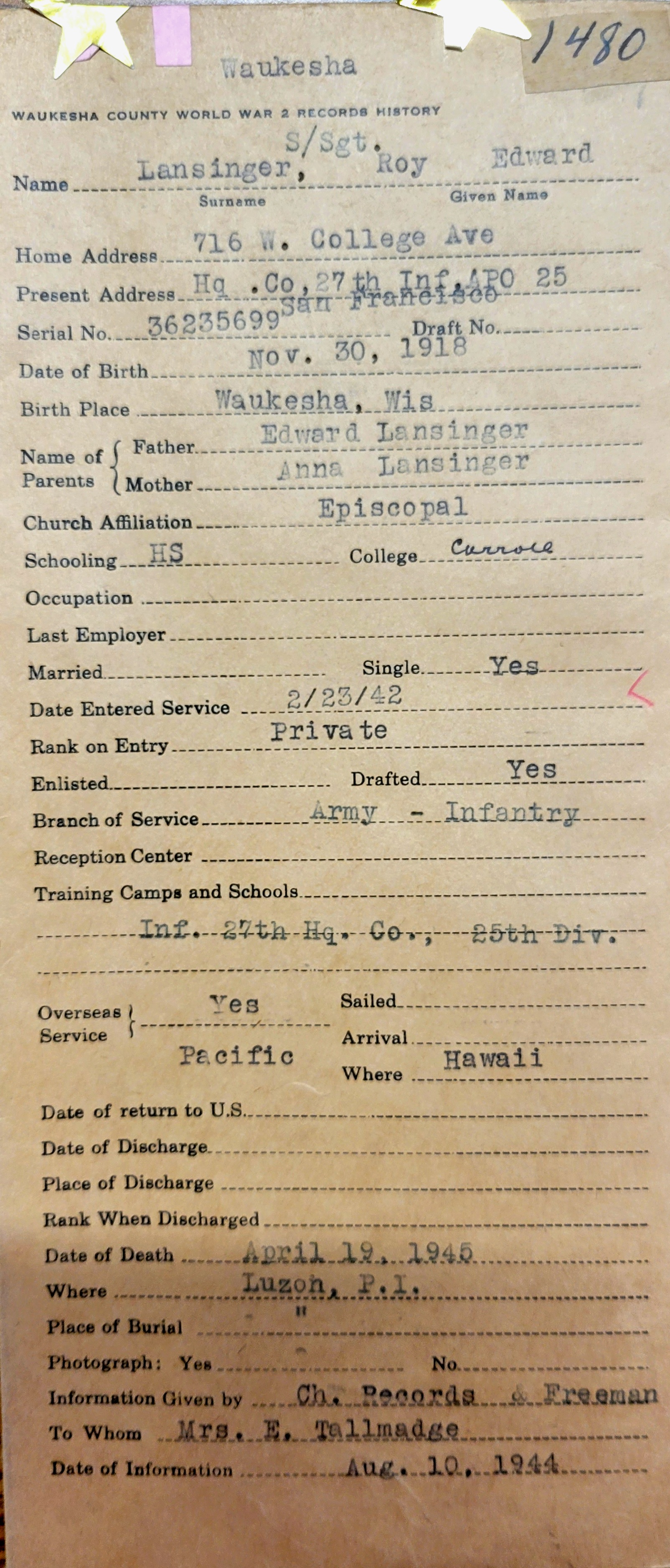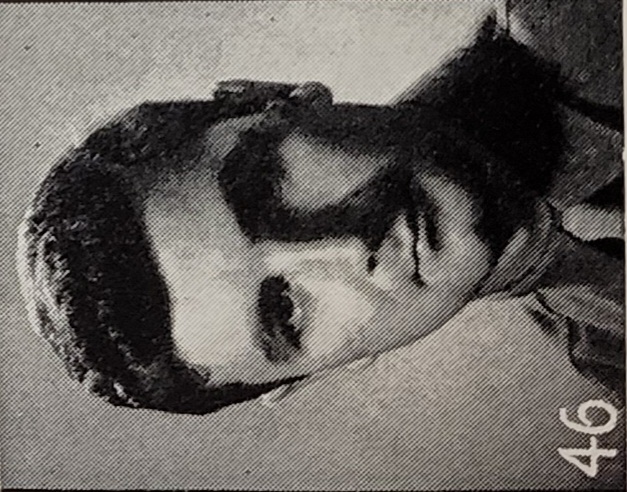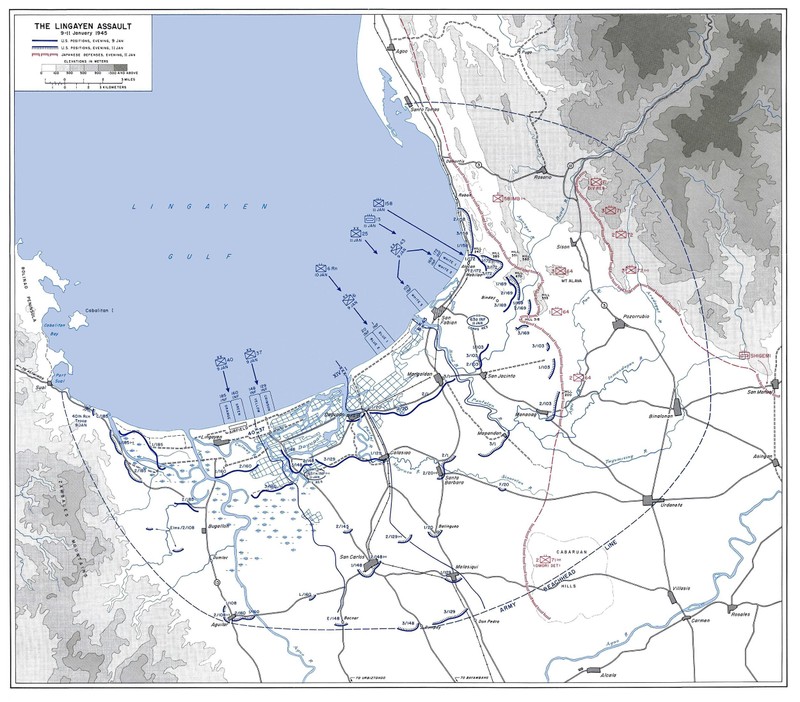The Story of Roy Lansinger
Introduction
Text-to-speech Audio
At 716 West College Avenue stands the childhood home of Roy Lansinger, an army veteran from Waukesha, Wisconsin. The Second World War engulfed the globe in conflict that touched every corner of the planet. The gentle town of Waukesha was no different and the people who lived there were just like anyone else in the world at that time. For this Wisconsinite, World War II would bring him not only the greatest adventure of his life but bring an end to that life in 1945.
Images
Roy Lansinger’s service card

Roy Lansinger in Waukesha Highschool yearbook, commemorating fallen alumni

Landings at Luzon near San Fabian

Backstory and Context
Text-to-speech Audio
Born November 30th , 1918 in Waukesha, Roy Lansinger was the second son of Edward and Anna Lansinger. He attended Waukesha High School in his teenage years like so many young men at the time. He would graduate high school in 1937 and have his picture featured in the yearbook alongside his classmates. The next year in 1938, Roy decided to further his education by attending the local college, Carroll. He quickly became recognized as an athletic individual and took part in many extracurriculars as some college students do. Running track and playing intermural volleyball were things he enjoyed immensely, and he was often featured in the Carroll Echo; the student newspaper. One entry highlighted the volleyball games of the week and read, “Dick Lockman and Roy Lansinger were solely responsible for the victory, with Lockman setting up for Lansinger who spiked the ball down for a great many of his team's points.” (George Poulos, 1941). When track season kicked off, articles raved about the first places he received in meets. In Roy’s junior year, he would rush for the Gamma Phi Delta Fraternity. In 1941, he would graduate from Carroll and be featured in the yearbook with his fellow classmates. The yearbook, The Hinakaga , pictured the senior class with blurbs alongside their names. Presumably written by the editors or fellow students, Roy’s blurb read, “Economics, shy, wavy hair. ‘I’ve got no use for the women’”. The latter of these listings being a song either students attributed to him or felt embodied his personality.
A year after graduating from Carroll, Roy was drafted into the U.S. army for compulsory military service. Assigned to the 25th Infantry Division, his unit specialized in jungle-warfare in the Asia-Pacific region. Training for the 25th was located at Schofield Barracks in Hawaii, where Roy was sent. American GIs at the time would go through “boot camp” where soldiers learned unit cohesion, weapons use, and stayed fit through physical exercise. This experience would be no different for Roy Lansinger and although he was drafted, he would have undoubtedly created the strongest of bonds with the men around him. While in the 25th Infantry Division, he was assigned to the 27th Regiment, a subunit of this military organization. Roy entered the U.S. army as private, like countless others around him.
His division saw grueling combat throughout the war, with the 25th Infantry Division being part of famous battles in the Pacific. On the 10th of January 1943, the 25th entered combat on Guadalcanal, seeing extended action through the jungle island. Afterwards, the division was transferred to New Zealand and then New Caledonia for training, refitting, and rest. For a Wisconsinite at the time like Roy, this was undoubtedly the first time he’d traveled so much and so far. The armed forces helped Roy see the world for the first time in a way he would have not experienced otherwise. While he certainly saw the horrors of warfare, these travels would have given him much to write about in his letters home. During this time, Roy was promoted to a staff sergeant after entering only as a private. Now, he was not only in charge of himself, but the lives of the men around him. By 1944, most staff sergeants would have overseen a rifle squad of 12 men. This would have been a great responsibility for Roy as his division was being cycled in and out of combat constantly.
On January 11, 1945, Roy Lansinger would embark on a final adventure that would change his life and his family's lives forever. On this day, the 25th Infantry Division would land near San Fabian, Luzon in the Philippines. The allies planned to take this island as a staging base for the anticipated invasion of Japan. Roy and his men were tasked with taking part in this great struggle. While in jungle terrain, disease was rife, and Malaria would have been running rampant through the body of the U.S. military. Despite these harsh factors, his unit moved East through the island, engaging the Japanese troops in harsh jungle combat. A month later, Roy’s unit would be tasked with moving up a highway on the island and taking Belete Pass, known today as Dalton Pass. It would be the site of a fierce battle in which the Japanese tried to counterattack the American lines several times. During one of these firefights, Roy Lansinger would give his life like so many other young Americans in the war. It’s not recorded how he was killed, but the Army recorded his official date of death as April 19, 1945. His body was not shipped home and, according to his service record, was buried on Luzon. Today, his body rests in the Manila American Cemetery on the neighboring island of Manila. His actions and sacrifice earned him a purple heart.
Roy Lansinger was just like any other young American of his generation. He went to school, loved his family, engaged in athletics and so much more. The story of World War II is a story of horrendous conflict reaching all corners of the planet and engulfing people from all walks of life. The people from Wisconsin were no different and the men who entered the armed forces would be shown the wider world for the first time. Although these horrors would bring an end to such a young life, the travels the Army would bring Roy had undoubtedly brought him the greatest adventures of his life. The world is grateful for his sacrifice.
Sources
- Poulos, George. “'Mural Volleyball Is in Full Sway.” The Carroll Echo. November 14, 1941, sec. AKN, Betas, Tekes Dominate All-Stars. https://archives.carrollu.edu/digital/collection/News/id/2096/rec/2
- Mann, B. David. “Japanese Defense of Bataan, Luzon, Philippine Islands, 16 December 1944-4 September 1945.” The Journal of Military History 67, no. 4 (2003): 1149–76. http://www.jstor.org/stable/3396885.
- U.S. Army Center of Military History. “25th Infantry Division.” World War II Divisional Combat Chronicles. Accessed March 12, 2023. https://history.army.mil/html/forcestruc/cbtchron/cc/025id.htm.
- Marshall, V. “Training the American GI: The National WWII Museum: New Orleans.” The National WWII Museum | New Orleans. The National World War II Museum, July 11, 2018. https://www.nationalww2museum.org/war/articles/training-american-gi#:~:text=Platoons%20of%20recruits%20slept%2C%20ate,unloading%2C%20and%20cleaning%20their%20weapons.
- United States Army. “Luzon: U.S. Army Center of Military History.” Luzon | U.S. Army Center of Military History. U.S. Army Center of Military History. Accessed March 12, 2023. https://history.army.mil/brochures/luzon/72-28.htm.
- Wikipedia. “25th Infantry Division (United States).” Wikipedia. Wikimedia Foundation, March 8, 2023. https://en.wikipedia.org/wiki/25th_Infantry_Division_(United_States).
- Wikipedia. “Dalton Pass.” Wikipedia. Wikimedia Foundation, February 4, 2022. https://en.wikipedia.org/wiki/Dalton_Pass.
- Wikipedia. “27th Infantry Regiment (United States).” Wikipedia. Wikimedia Foundation, October 13, 2022. https://en.wikipedia.org/wiki/27th_Infantry_Regiment_(United_States).
- Carroll University, The Hinakaga (Waukesha, Wisconsin: 1941), 30, Carroll University Digital Archives.
- Carroll University, The Hinakaga (Waukesha, Wisconsin: 1941), 84, Carroll University Digital Archives.
- "St. Norbert's next foe for trackmen." The Carroll Echo. May 17, 1940. https://archives.carrollu.edu/digital/collection/News/id/1555/rec/7
- Carroll University, The Hinakaga (Waukesha, Wisconsin: 1940), 30, Carroll University Digital Archives.
- G.I. History Handbook. Organization of the WWII U.S. Army Infantry Rifle Platoon. YouTube. YouTube, 2018. https://www.youtube.com/watch?v=Gdudv8jPe84.
Waukesha Historical Society
Waukesha Historical Society
United States Army. “Map of Landing Beaches in Lingayen Gulf, Luzon, Philippine Islands, 9 Jan 1945.” World War II Database. David Stubblebine, January 1, 2006. https://ww2db.com/image.php?image_id=24858.
